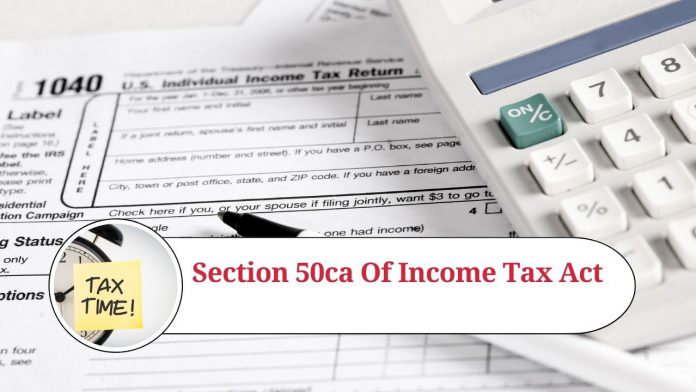Section 50CA of the Income Tax Act was introduced in the Finance Act, of 2017, and it has caused a stir in the business community. The section was introduced to tackle the problem of undervaluation of shares and assets during the transfer of a company. This section has far-reaching implications for all stakeholders involved in the transfer of shares or assets. In this article, we will discuss the provisions of section 50CA of the Income Tax Act, its impact on businesses, and the way forward.
Provisions of Section 50CA:
Section 50CA of the Income Tax Act is applicable when there is a transfer of shares or assets between related parties. The section states that the fair market value of the shares or assets will be considered the full value of consideration. This means that if the transaction value is less than the fair market value, the difference will be added to the income of the transferor.
The fair market value of the shares or assets will be determined as per Rule 11UA of the Income Tax Rules, 1962. The rule provides for the method of valuation, which includes the discounted cash flow method, net asset value method, and comparable uncontrolled price method.
The section applies to all kinds of transfers, including the sale, exchange, relinquishment, and extinguishment of any right.
Impact on Businesses:
The introduction of Section 50CA of the Income Tax Act has significant implications for businesses. It has made the transfer of shares or assets between related parties more complex and challenging. Earlier, businesses used to undervalue the shares or assets during the transfer to reduce the tax liability. However, with the introduction of this section, businesses have to ensure that the transaction value is not less than the fair market value.
The section has also increased the compliance burden on businesses. They have to maintain proper documentation to prove that the transaction value is not less than the fair market value. The valuation of the shares or assets has to be done by a registered valuer, and the report has to be submitted to the Income Tax Department.
The way forward:
To comply with the provisions of Section 50CA of the Income Tax Act, businesses have to take several steps. They have to engage a registered valuer to determine the fair market value of the shares or assets. The valuation report has to be submitted to the Income Tax Department along with the tax returns.
Businesses have to maintain proper documentation to prove that the transaction value is not less than the fair market value. The documentation should include the valuation report, the agreement between the parties, and any other relevant documents.
Conclusion:
In conclusion, Section 50CA of the Income Tax Act has significant implications for businesses involved in the transfer of shares or assets. The section has made the transfer more complex and increased the compliance burden on businesses. To comply with the provisions of the section, businesses have to engage a registered valuer, maintain proper documentation, and ensure that the transaction value is not less than the fair market value. The introduction of this section is a step towards curbing the practice of undervaluation of shares and assets during the transfer and ensuring that the government receives its fair share of taxes.
Read more useful content:
Frequently Asked Questions:
Q: What is Section 50CA of the Income Tax Act?
A: Section 50CA of the Income Tax Act was introduced in the Finance Act, of 2017, to tackle the problem of undervaluation of shares and assets during the transfer of a company. The section applies to transfers between related parties and requires that the fair market value of the shares or assets be considered the full value of consideration.
Q: When does Section 50CA apply?
A: Section 50CA applies to all kinds of transfer, including sale, exchange, relinquishment, and extinguishment of any right, between related parties.
Q: Who are considered related parties for Section 50CA?
A: Related parties include persons who are connected in a manner as specified under Section 40A(2) of the Income Tax Act. This includes individuals, HUFs, companies, and firms, among others.
Q: How is the fair market value of shares or assets determined under Section 50CA?
A: The fair market value of shares or assets is determined as per Rule 11UA of the Income Tax Rules, 1962. The rule provides for the method of valuation, which includes the discounted cash flow method, net asset value method, and comparable uncontrolled price method.
Q: What happens if the transaction value is less than the fair market value under Section 50CA?
A: If the transaction value is less than the fair market value, the difference will be added to the income of the transferor.
Q: What are the implications of Section 50CA on businesses?
A: Section 50CA has made the transfer of shares or assets between related parties more complex and increased the compliance burden on businesses. They have to engage a registered valuer, maintain proper documentation, and ensure that the transaction value is not less than the fair market value.
Q: Is it mandatory to engage a registered valuer for Section 50CA?
A: Yes, it is mandatory to engage a registered valuer to determine the fair market value of the shares or assets.
Q: What documents are required to comply with the provisions of Section 50CA?
A: Businesses have to maintain proper documentation, which should include the valuation report, the agreement between the parties, and any other relevant documents.
Q: What is the way forward for businesses to comply with Section 50CA?
A: To comply with Section 50CA, businesses have to engage a registered valuer, maintain proper documentation, and ensure that the transaction value is not less than the fair market value.




















